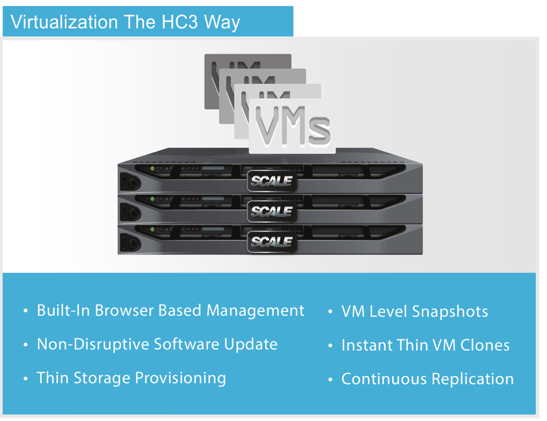Scale Computing Expands Reach of Hyperconvergence With Single Node Appliance
Provides benefits of replication and remote management for DR and distributed enterprise deployments.
This is a Press Release edited by StorageNewsletter.com on October 31, 2016 at 2:47 pmScale Computing, Inc. introduced a single-node configuration of its HC3 virtualization platform, designed to deliver flexible hyperconverged infrastructure for distributed enterprise and DR use cases.

IT departments are often challenged to deploy DR and remote office infrastructures on a tight budget while maintaining enterprise capabilities. While hyperconvergence provides a wide range of benefits, it is generally only available in multi-node clustered configurations, often over specifying the needs of DR sites or ROBOs. Deploying this single node configuration alongside firm’s HC3 clusters enables IT departments to deliver DR and remote office infrastructure on a tight budget while maintaining enterprise capabilities.
“We are seeing increasing technology demands from the SMB and midmarket sectors, in fact, 78% of SMBs are saying that technology is more important to them today than previous years,” said Anurag Agrawal, CEO and analyst, Techaisle LLC. “The SMB/midmarket often do not have the means in way of budget, knowledge or IT staff to be able to implement much needed newer technologies. Techaisle’s survey shows that 72% of SMBs wants IT vendors to simplify technology and 61% are ignoring some technologies due to complexity even though they may be useful for business success. Scale Computing continues to be a champion in this space allowing small to midsize companies the immediate ability to leverage the benefits of hyperconvergence, flash, analytics, VDI and DRaaS within a single platform by removing the complexity and cost normally associated with adopting these technologies.“
Company’s HC3 platform brings storage, servers, virtualization and management together in a single system. With no virtualization software to license and no external storage to buy, HC3 products lower costs and simplify the infrastructure needed to keep applications running.
For DR and remote availability, it is common to target a smaller infrastructure footprint to conserve budget. With the single-node appliance configuration, there is no need to maintain an entire duplicate of production infrastructure when a smaller infrastructure is enough to run critical workloads until primary sites are restored. This not only reduces the DR infrastructure cost but further simplifies DR planning by focusing on key critical workloads rather than non-essentials.
In the distributed enterprise, remote sites often only need a handful of workloads and even a minimum cluster with multiple nodes can be excessive. Because these sites often have little or no IT expertise present, the simplicity of hyperconvergence is a greater benefit. HC3’s remote management capabilities make it easier for the IT staff, usually located at a central office, to avoid costly travel when supporting remote sites.
“At Scale Computing, we’ve always offered HC3 in clusters of three or more appliances but we have also recognized that there are some instances we could address where even a three-node cluster is an overkill,” said Jeff Ready, CEO and co-founder, Scale Computing. “We decided to offer a single-node appliance configuration that can be deployed alongside HC3 clusters to enable distributed enterprise and DR use cases that provide more flexibility and cost savings than traditional cluster configurations.“














 Subscribe to our free daily newsletter
Subscribe to our free daily newsletter


